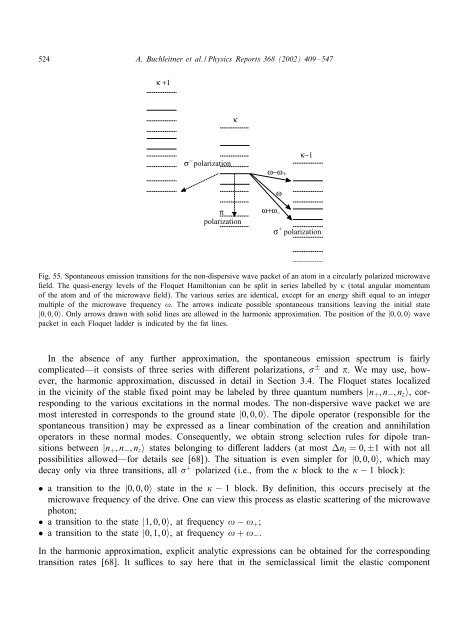Non-dispersive wave packets in periodically driven quantum systems
Non-dispersive wave packets in periodically driven quantum systems
Non-dispersive wave packets in periodically driven quantum systems
Create successful ePaper yourself
Turn your PDF publications into a flip-book with our unique Google optimized e-Paper software.
524 A. Buchleitner et al. / Physics Reports 368 (2002) 409–547<br />
κ +1<br />
σ − polarization<br />
κ<br />
π<br />
polarization<br />
ω−ω +<br />
ω<br />
ω+ω −<br />
κ−1<br />
σ + polarization<br />
Fig. 55. Spontaneous emission transitions for the non-<strong>dispersive</strong> <strong>wave</strong> packet of an atom <strong>in</strong> a circularly polarized micro<strong>wave</strong><br />
eld. The quasi-energy levels of the Floquet Hamiltonian can be split <strong>in</strong> series labelled by (total angular momentum<br />
of the atom and of the micro<strong>wave</strong> eld). The various series are identical, except for an energy shift equal to an <strong>in</strong>teger<br />
multiple of the micro<strong>wave</strong> frequency !. The arrows <strong>in</strong>dicate possible spontaneous transitions leav<strong>in</strong>g the <strong>in</strong>itial state<br />
|0; 0; 0〉. Only arrows drawn with solid l<strong>in</strong>es are allowed <strong>in</strong> the harmonic approximation. The position of the |0; 0; 0〉 <strong>wave</strong><br />
packet <strong>in</strong> each Floquet ladder is <strong>in</strong>dicated by the fat l<strong>in</strong>es.<br />
In the absence of any further approximation, the spontaneous emission spectrum is fairly<br />
complicated—it consists of three series with di erent polarizations, ± and . We may use, however,<br />
the harmonic approximation, discussed <strong>in</strong> detail <strong>in</strong> Section 3.4. The Floquet states localized<br />
<strong>in</strong> the vic<strong>in</strong>ity of the stable xed po<strong>in</strong>t may be labeled by three <strong>quantum</strong> numbers |n+;n−;nz〉, correspond<strong>in</strong>g<br />
to the various excitations <strong>in</strong> the normal modes. The non-<strong>dispersive</strong> <strong>wave</strong> packet we are<br />
most <strong>in</strong>terested <strong>in</strong> corresponds to the ground state |0; 0; 0〉. The dipole operator (responsible for the<br />
spontaneous transition) may be expressed as a l<strong>in</strong>ear comb<strong>in</strong>ation of the creation and annihilation<br />
operators <strong>in</strong> these normal modes. Consequently, we obta<strong>in</strong> strong selection rules for dipole transitions<br />
between |n+;n−;nz〉 states belong<strong>in</strong>g to di erent ladders (at most ni =0; ±1 with not all<br />
possibilities allowed—for details see [68]). The situation is even simpler for |0; 0; 0〉, which may<br />
decay only via three transitions, all + polarized (i.e., from the block to the − 1 block):<br />
• a transition to the |0; 0; 0〉 state <strong>in</strong> the − 1 block. By de nition, this occurs precisely at the<br />
micro<strong>wave</strong> frequency of the drive. One can view this process as elastic scatter<strong>in</strong>g of the micro<strong>wave</strong><br />
photon;<br />
• a transition to the state |1; 0; 0〉, at frequency ! − !+;<br />
• a transition to the state |0; 1; 0〉, at frequency ! + !−.<br />
In the harmonic approximation, explicit analytic expressions can be obta<strong>in</strong>ed for the correspond<strong>in</strong>g<br />
transition rates [68]. It su ces to say here that <strong>in</strong> the semiclassical limit the elastic component











